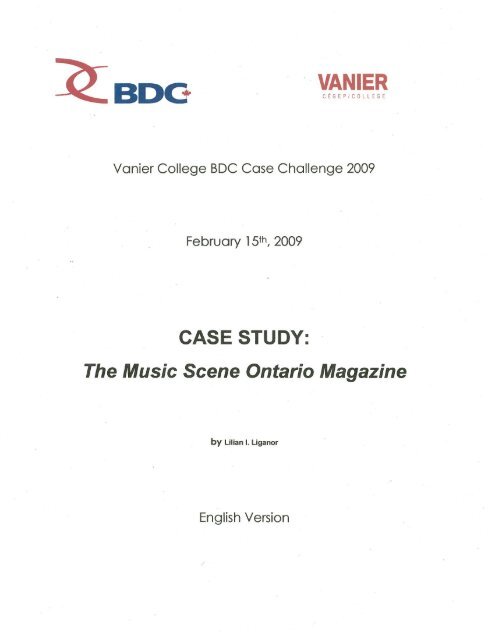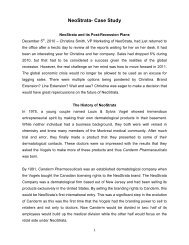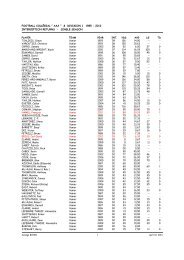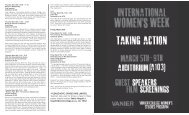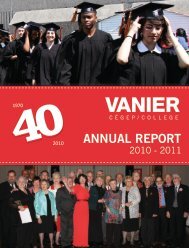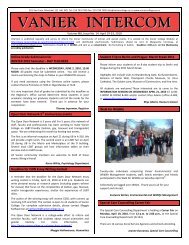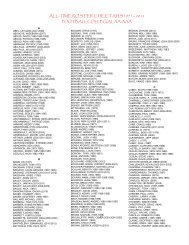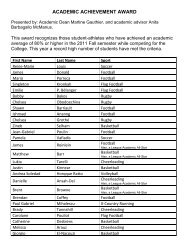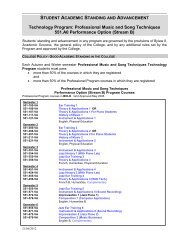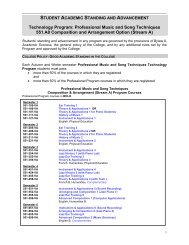CASE STUDY: The Music Scene Ontario Magazine - Vanier College
CASE STUDY: The Music Scene Ontario Magazine - Vanier College
CASE STUDY: The Music Scene Ontario Magazine - Vanier College
You also want an ePaper? Increase the reach of your titles
YUMPU automatically turns print PDFs into web optimized ePapers that Google loves.
<strong>CASE</strong> <strong>STUDY</strong>: <strong>The</strong> <strong>Music</strong> <strong>Scene</strong> <strong>Ontario</strong> <strong>Magazine</strong><br />
Background<br />
In 1996, Wah Keung Chan, a mathematics doctorial student with a history of initiating projects from a<br />
young age, began a small hobby that would evolve into an important contribution to the arts scene in<br />
Quebec, Canada and internationally. As a music lover and an aspiring opera singer, he created a twopage<br />
bilingual newsletter on vocal classical music (opera, choral and voice recitals) which he initially<br />
called La Scena Vocale, Italian for “<strong>The</strong> Vocal <strong>Scene</strong>.” Chan chose an Italian name for his newsletter<br />
to avoid adding to the Quebec linguistic tensions that followed the dramatic 1995 Quebec<br />
Referendum. <strong>The</strong> first issue had a one-page calendar of local music events and featured an article on<br />
the back page. In all, 300 manually-folded photocopies were distributed to music schools and concert<br />
venues throughout Montreal while an electronic version was sent by e-mail to thirty friends and posted<br />
on the internet through usenet groups. Feedback about the newsletter was very positive and it<br />
seemed that it addressed a real need. Over the next 8 months, the number of copies grew from 500 to<br />
4000 copies per issue and each issue increased in size from 2 to 8 pages.<br />
In May 1997, the little newsletter blossomed into a “real” magazine at 16 pages, and it was renamed<br />
La Scena <strong>Music</strong>ale (LSM), Italian for “<strong>The</strong> <strong>Music</strong> <strong>Scene</strong>,” covering all of classical music, not just<br />
vocals, and including a comprehensive music events calendar, CD reviews, articles and interviews. La<br />
Scène <strong>Music</strong>ale was formed as a non-profit organization (gaining charitable status in 2002) with a<br />
mission to actively promote classical music through the publication of LSM as a bilingual music<br />
magazine. <strong>The</strong> organization’s non-profit model was chosen for the Quebec market to enable La<br />
Scène <strong>Music</strong>ale to qualify for government grants and to attract much-needed volunteers. More<br />
importantly, from the very start, and unlike traditional newsstand arts magazines with very limited<br />
circulation, La Scène <strong>Music</strong>ale fulfilled its mission of making classical music more publicly accessible<br />
by adopting the innovative controlled (free) circulation distribution method, an approach which allowed<br />
LSM to reach a larger readership. In fact, LSM is the first Quebec arts magazine to be distributed in<br />
this way.<br />
La Scène <strong>Music</strong>ale built its LSM brand (many readers affectionately refer to the magazine as “La<br />
Scena”) on relevant and cutting-edge editorial, including expert advice to singers on topics such as<br />
how to handle colds, introducing readers to rising Canadian stars such as tenor Ben Heppner and<br />
soprano Isabel Bayrakdarian, as well as featuring talented Quebec artists like soprano Lyne Fortin<br />
and conductor Jacques Lacombe.<br />
1
<strong>The</strong> magazine started its second full year in September 1997 as a larger 24-page publication featuring<br />
Quebec conductor Bernard Labadie. Distribution increased by 286% from the inaugural issue<br />
published the previous year (7000 copies) to 20,000 copies in the second year. Since then the<br />
magazine continues to be published ten times a year with two issues combining two months -<br />
December/January and July/August.<br />
In subsequent years, La Scène <strong>Music</strong>ale’s flagship magazine La Scena <strong>Music</strong>ale (LSM) has evolved<br />
into a hybrid glossy/newsprint 80-page magazine that is considered the most respected music<br />
magazine in Canada (with jazz and world music added to its coverage). At one time, LSM’s circulation<br />
was as high as 42,000 copies per issue, and it continued to take an international perspective with<br />
features on world-renowned artists such as Oliver Jones, Charles Dutoit, Yo-Yo Ma, Lang Lang,<br />
Renée Fleming, and Placido Domingo. Through its award-winning website, scena.org, LSM has<br />
become one of the most prestigious online music magazines in the world. Currently, the site attracts<br />
an average of 7000 visitors a day and includes a blog for classical music enthusiasts.<br />
<strong>The</strong> Business Model<br />
From the outset, LSM was conceived as a bridge to connect musicians, music groups and music<br />
lovers (“consumers”). It caters to musicians, music experts and music novices alike. Surveys<br />
conducted through the years show that the average reader of the magazine is highly-educated (92%<br />
are college-educated or higher), affluent, and of above-average age (median age of 49 versus the<br />
Canadian average of 43 - see Appendix 1: Readership Profile).<br />
During its second year of publication La Scène <strong>Music</strong>ale began printing LSM on newsprint using a<br />
more cost-effective process. Later, in 2000, LSM introduced its first colour cover (4 pages in total<br />
considering both sides of the front and back pages). <strong>The</strong> number of colour glossy pages gradually<br />
increased, fluctuating between 16 and 32 pages (note that magazine sections normally come in<br />
increments of 16 pages) depending on the issue. Three years ago, La Scène <strong>Music</strong>ale decided to<br />
improve the quality of its end-product. By reducing the number of copies per issue from 42,000 to<br />
25,000 it was able to invest more money into more colour pages per issue. Upgrading the overall<br />
quality of the magazine would help attract more lucrative advertising. Presently, LSM advertising rates<br />
are $1,300 for full-page black and white ads, and $2300 for full-page colour ads.<br />
2
Overall, a major portion of LSM’s revenues is derived from advertising. Web advertising has increased<br />
in recent years, but similar to subscription and donation revenues it accounts for only a small<br />
percentage of the magazine’s revenues. Youth employment grants is another small source of funds,<br />
and to date, LSM has not been eligible for government funding, partly because it continues to use the<br />
controlled (free) circulation method of distribution.<br />
<strong>The</strong> first advertisers in LSM were concert presenters (regular season presenters who do promotions<br />
from September to May, and summer festival advertisers who buy ads for June, July and August).<br />
After two years, advertising from the CD industry came onboard. With the addition of the annual<br />
Higher Education Guide to its November issue, LSM expanded its advertising base to the education<br />
sector. <strong>The</strong> music and arts sectors remain the bulk of LSM’s advertising business but because these<br />
sectors typically have tight budgets, heavy advertising discounts are offered to these organizations.<br />
In September 2006, La Scène <strong>Music</strong>ale extended its mission of promoting music to include the arts in<br />
general so as to reach a larger audience and to broaden its advertising scope. Traditionally published<br />
ten times a year as a stand-alone music magazine, La Scena <strong>Music</strong>ale (LSM) now expands into a<br />
larger magazine called La SCENA for four out of its ten issues (i.e., LSM “becomes” La SCENA in<br />
April, June, September, December/January). La SCENA, the arts magazine, not only covers dance,<br />
theatre, film and the visual arts but it also incorporates the LSM magazine inside as its music<br />
component. Whenever it publishes La SCENA, La Scène <strong>Music</strong>ale adopts a more high-end perfectly<br />
bound format (not stapled, similar to paperback book binding). With its remaining six issues, when<br />
LSM exists as a stand-alone music magazine and is therefore not part of La SCENA, it is presented in<br />
a simpler saddle-stitched (stapled) format.<br />
<strong>The</strong> Quebec <strong>Music</strong> and Arts Market<br />
<strong>The</strong> Canadian CD/music DVD industry is estimated to be over $200 million for 2007. In recent years<br />
the sales of CDs and music DVDs have been declining (according to the Canadian Record Industry<br />
Association, the industry saw as much as a 35% sales decline during the first quarter of 2007 - $69<br />
million from $106 million in the same period in 2006). 1<br />
Increased online downloading of music and<br />
music videos account for much of the progressive deterioration of hardcopy sales. Despite this,<br />
Quebec continues to be viewed as an interesting market. Even though the province represents only<br />
about 24% of the Canadian population, it has higher CD sales per capita (according to some industry<br />
experts as much as 35% of classical music CDs are sold in Quebec) than in other markets in the<br />
country.<br />
1 Greg Quill, “CD music sales plummet,” Today’s Toronto Star, December 7, 2008 (http://www.thestar.com/entertainment/article/207826)<br />
3
Another reason why the Quebec music and arts scene is doing better than other markets is that the<br />
Quebec government continues to spend more on the arts per capita than other provinces leading to a<br />
thriving festival scene during the summer season. Nevertheless, being largely dependent on music<br />
and arts advertising revenues, La Scène <strong>Music</strong>ale’s success could be adversely affected by the<br />
negative trend in the CD/music DVD industry.<br />
For the past few years, La Scène <strong>Music</strong>ale has taken the initiative to develop sales from other<br />
sectors. Efforts to expand LSM’s sales to retail and national clients (non-arts advertisers) have been<br />
hampered by its limited sales staff. Another challenge in securing the business of national advertisers<br />
is the lack of membership in the Print Measurement Bureau (a non-profit organization which collects<br />
useful statistics on print media readership for its member organizations). Membership in the PMB<br />
would enable LSM to track statistics on its readership base and on the Canadian publishing industry,<br />
a powerful sales tool to help persuade potential national advertisers to buy ad space in the magazine.<br />
PMB fees, however, are costly (about $12,000 per year) and are currently beyond LSM’s budget.<br />
National Presence<br />
Canada’s magazine business is a $2.1 billion industry (2006) with advertising spending on magazines<br />
increasing significantly (92%) in the past 13 years. 2<br />
Like many Quebec-based organizations seeking<br />
to reach the next level, La Scène <strong>Music</strong>ale realizes that it must secure business outside the province,<br />
but finding advertisers in English Canada and internationally, requires a strong national presence. In<br />
1999, the organization attempted to expand LSM’s distribution to Toronto, but that proved financially<br />
premature especially in light of local competition (from <strong>The</strong> Whole Note, an established Toronto<br />
competitor). More importantly, it became evident that the bilingual nature of the magazine was a “turnoff”<br />
for English Canada; many readers mistook LSM’s Italian name as French, and ignored the<br />
magazine. Chan concluded that to gain better access to the rest of Canada, a new and all-English<br />
product was needed. In 2002, an all-English magazine targeted to <strong>Ontario</strong> and Western Canada,<br />
called <strong>The</strong> <strong>Music</strong> <strong>Scene</strong> (TMS) was introduced. It has been published with irregular frequency,<br />
varying between twice and four times a year (see Table 1: <strong>The</strong> <strong>Music</strong> <strong>Scene</strong> Publication History).<br />
TMS follows the same standards of excellence established for La Scène <strong>Music</strong>ale’s flagship bilingual<br />
magazine, La Scena <strong>Music</strong>ale (LSM), and has featured musicians such as Measha Brueggergosman,<br />
Isabel Bayrakdarian, Cecilia Bartoli, Sumi Jo, Valeri Gergiev, Richard Bradshaw and Tafelmusik.<br />
2 TCI Management Consultants, A Strategic Study of the <strong>Magazine</strong> Industry in <strong>Ontario</strong>: Final Report for the <strong>Ontario</strong> Media Development<br />
Corporation <strong>Magazine</strong> Industry Advisory Committee (<strong>Ontario</strong>, Canada, September 30, 2008), 3.<br />
4
Originally, TMS had a 42,000-copy distribution per issue and was distributed as a controlled (free)<br />
circulation magazine in <strong>Ontario</strong> and in Western Canada. Three years ago, TMS was divided into two<br />
separate regional editions (TMS <strong>Ontario</strong> and TMS West) with each edition having 25,000 copies per<br />
issue. Advertising support in Western Canada proved disappointing and TMS West has, for the time<br />
being, been discontinued. TMS <strong>Ontario</strong> continues to be published twice a year and is distributed<br />
throughout Toronto and Ottawa.<br />
TABLE 1: <strong>The</strong> <strong>Music</strong> <strong>Scene</strong> (TMS) Publication History<br />
Year Issues Avg. Copies/Issue Distribution<br />
2002-03 2 42,000 <strong>Ontario</strong>, Western Canada<br />
2003-04 3 42,000 <strong>Ontario</strong>, Western Canada<br />
2004-05 4 42,000 <strong>Ontario</strong>, Western Canada<br />
2005-06 4 40,000 <strong>Ontario</strong>, Western Canada<br />
2006-07 2 25,000 <strong>Ontario</strong>, music schools across Canada<br />
2007-08 2 25,000 <strong>Ontario</strong>, music schools across Canada<br />
2008-09 2 25,000 <strong>Ontario</strong>, music schools across Canada<br />
In Toronto and in Southern <strong>Ontario</strong>, <strong>The</strong> <strong>Music</strong> <strong>Scene</strong> (TMS) faces existing competition at various<br />
levels:<br />
<strong>The</strong> Whole Note<br />
• 13 year-old Toronto-based English magazine on classical, choral, jazz, world and theatre<br />
music, and opera<br />
• 30,000 copies per issue and published 10 times a year<br />
• printed on newsprint with colour matte cover<br />
• controlled (free) distribution in Southern <strong>Ontario</strong>, mainly in Toronto<br />
• like TMS, there is an online downloadable version of the magazine<br />
• Its advantage over TMS is its publication frequency, local presence and focus in Toronto,<br />
advertiser loyalty and the inclusion of a free events calendar. On the other hand, TMS has a<br />
relatively higher quality presentation (more professional layout, graphics and writing), and<br />
produces more interesting editorial content with national and international focus.<br />
Opera Canada<br />
• 50 year-old Toronto-based English magazine dedicated to opera<br />
• 5,000 copies per issue and published 5 times a year<br />
• printed entirely on colour matte paper and provides a calendar of global opera performances.<br />
• available by subscription and at select newsstands<br />
• no online downloadable version of the magazine is available<br />
• introduced the Opera Canada Awards which is better known as “<strong>The</strong> Rubies” (in 2000) as a<br />
major fund-raising event for the magazine<br />
• Opera Canada and TMS have comparable editorial quality but TMS has 5 times more copies<br />
per issue, making it more attractive to advertisers.<br />
Opus<br />
• 30-year old Toronto-based English classical music magazine<br />
• 4,000 copies per issue and published 4 times a year<br />
• printed entirely on colour matte paper<br />
• available by subscription and at select newsstands<br />
• no online downloadable version of the magazine is available<br />
NOTE: According to industry sources, Opus has recently ceased publication.<br />
5
Other classical music magazines from outside Canada such as Opera <strong>Magazine</strong>, Gramophone, and<br />
BBC <strong>Music</strong> <strong>Magazine</strong> are available by subscription and/or at select newsstands.<br />
<strong>The</strong> Future of <strong>The</strong> <strong>Music</strong> <strong>Scene</strong> <strong>Ontario</strong><br />
Wah Keung Chan is faced with the question of what to do with TMS <strong>Ontario</strong>. Despite existing<br />
competition, Chan sees increasing potential in <strong>Ontario</strong>. Under the McGinty government, <strong>Ontario</strong> has<br />
increased funding to the arts and to publishing sectors through the <strong>Ontario</strong> Arts Council (OAC) and<br />
through the <strong>Ontario</strong> Media Development Corporation (OMDC). Furthermore, the OAC has changed its<br />
funding eligibility criteria so that controlled (free) circulation magazines are now eligible to apply.<br />
Toronto particularly boasts a thriving arts scene supported by recent infrastructure investments<br />
including new facilities for the Art Gallery of <strong>Ontario</strong>, the Royal <strong>Ontario</strong> Museum, the Four Seasons<br />
Performing Arts Centre, and the renovated Royal Conservatory of <strong>Music</strong>. With all this support,<br />
Toronto enjoys the enviable reputation as Canada’s “cultural capital.”<br />
As Chan ponders the future development of TMS <strong>Ontario</strong>, many ideas come to mind. According to<br />
industry experts, most consumer magazines in Canada will exist in print form despite the digital<br />
culture. 3<br />
Since it helps fill the need for music education in <strong>Ontario</strong> one idea would be to focus the<br />
magazine mainly to musicians and music students and to this end, target education and instrument<br />
advertisers. Another strategy could be to distribute the magazine door-to-door by mail in more affluent<br />
neighbourhoods (in the Greater Toronto Area), a method used by many magazines, in TMS’s case, to<br />
increase subscriptions, and to widen the scope of non-arts advertisers (e.g., restaurants, car<br />
dealerships, etc.) TMS <strong>Ontario</strong> could also follow the combined La Scena <strong>Music</strong>ale/La SCENA strategy<br />
by expanding its coverage to the other arts, a direction which would require the magazine to offer<br />
more and diversified content as well as add to production costs due to an increase in the number of<br />
pages per issue.<br />
Even with more administrative support in the past few years, Chan still runs a very lean organization<br />
and relies heavily on a small but dedicated army of volunteers. He continues to oversee every aspect<br />
of the organization, La Scène <strong>Music</strong>ale, out of his Montreal office keeping busy with editorial, sales<br />
and marketing. As the founder, editor and publisher of three notable magazines, La Scena <strong>Music</strong>ale<br />
(LSM), La SCENA, and <strong>The</strong> <strong>Music</strong> <strong>Scene</strong> (TMS) as well as the online magazine, scena.org, his<br />
passion for music and the arts drives his organization’s ongoing mission to make classical music and<br />
the arts more readily available to the public.<br />
3 TCI 15<br />
6
With a shoestring budget and no operating grants from the government, Chan must constantly come<br />
up with creative means to promote his magazines. His annual promotional budget of $75,000 largely<br />
comes from exchanges (barters) with radio, television and arts groups.<br />
Chan firmly believes that culture is not a privilege for the wealthy few but a right for every Canadian.<br />
Having been the “front man” of the organization for 13 years, Chan knows well the challenges of trying<br />
to effectively allocate La Scène <strong>Music</strong>ale’s limited resources in order to continue being of service to<br />
the Canadian public. As noted musicologist Jean-Jacques Nattiez once remarked, “If La Scena<br />
<strong>Music</strong>ale did not exist, it would have to be invented.” Chan realizes that he must focus more of his<br />
time to leveraging his innovation and industry experience toward secure additional business<br />
development and fundraising opportunities beyond the province of Quebec. Building the <strong>The</strong> <strong>Music</strong><br />
<strong>Scene</strong> <strong>Ontario</strong> brand may be part of the solution.<br />
This original case was prepared for the 2009 BDC <strong>Vanier</strong> <strong>College</strong> Case Competition by L. I.<br />
Liganor BSc, MBA. Some of the facts and figures have been modified to maintain<br />
confidentiality. <strong>The</strong> author would like to thank Wah Keung Chan for his cooperation and<br />
generosity in the preparation of this case.<br />
7


